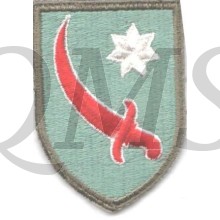Mouwembleem Persian Gulf Command (Sleeve patch Persian Gulf Command)
The Persian Gulf Command was a United States Army service command established in December 1943 to assure the supply of U.S. lend-lease war material to the Soviet Union. Its history originated in September 1941, when the U.S. Military Iranian Mission led by Engineer officer COL Raymond A. Wheeler (later CG) was established to facilitate lend-lease supply to the U.S.S.R.At this same time, the Iranian District of the North Atlantic Division was set up to provide construction support. In August 1942 the mission was re-designated as the Persian Gulf Service Command, and in December 1943 became the Persian Gulf Command. It subsequently came under the command of a succession of engineer generals. Following the War Department’s full militarization of construction, the Iranian District ceased to exist in May 1943. Three districts directly subordinate to the area command eventually replaced it. Eventually thousands of personnel worked in Iraq as well.
Iran was already occupied by British and Russian troops who were guarding the oil fields and keeping an eye on the pro-German Iranians (Persians). Hitler believed that German military forces could eventually take possession of the oil fields and the railroad that went through the mountains from the Persian Gulf to the Russian border.
Conditions in Persia were new and foreign, and hotter than anything Americans had previously trained for. Those who arrived in the summer of 1942 were welcomed by pouring rain and mud more than a foot deep. This is where they had to pitch their tents to sleep on the ground for the next six months until huts were built. The rainy season was followed by temperatures that rose as high as 170 degrees in the desert sun, accompanied by sand storms that persisted for as long as a week as they constantly changed the landscape.
Between 1942 and 1945, the United States helped to equip Russia with 192 thousand trucks and thousands of aircraft, combat vehicles, tanks, weapons, ammunition and petroleum products. Before the construction of the aircraft assembly plant at Abadan, Iran, the United States Army Air Forces flew A-20 medium bombers across the Atlantic to Abadan, where they were turned over to Russian flyers. Army engineers transformed the camel paths into a highway for trucks and improved the railroad with its more than 200 tunnels so trains could carry tanks and tons of other heavy equipment over the mountains. Historian David Glantz has concluded that U.S. and British lend-lease assisted Soviet victory on the Eastern Front, but it was not a critical factor: 'left to themselves, the Soviets might have taken 12 to 18 months longer to defeat the Wehrmacht.
The Command, in conjunction with the British Tenth Army and Soviet troops, also provided security for the Teheran Conference in the fall of 1943, the meeting of United States President Franklin D. Roosevelt, British Prime Minister Winston Churchill, and Soviet Premier Joseph Stalinin the capital city of Iran. Allied troops all over the country were on the alert to protect the Big Three. The British, Soviet and American troops together prevented a German assassination attempt on the leaders at the conference.



